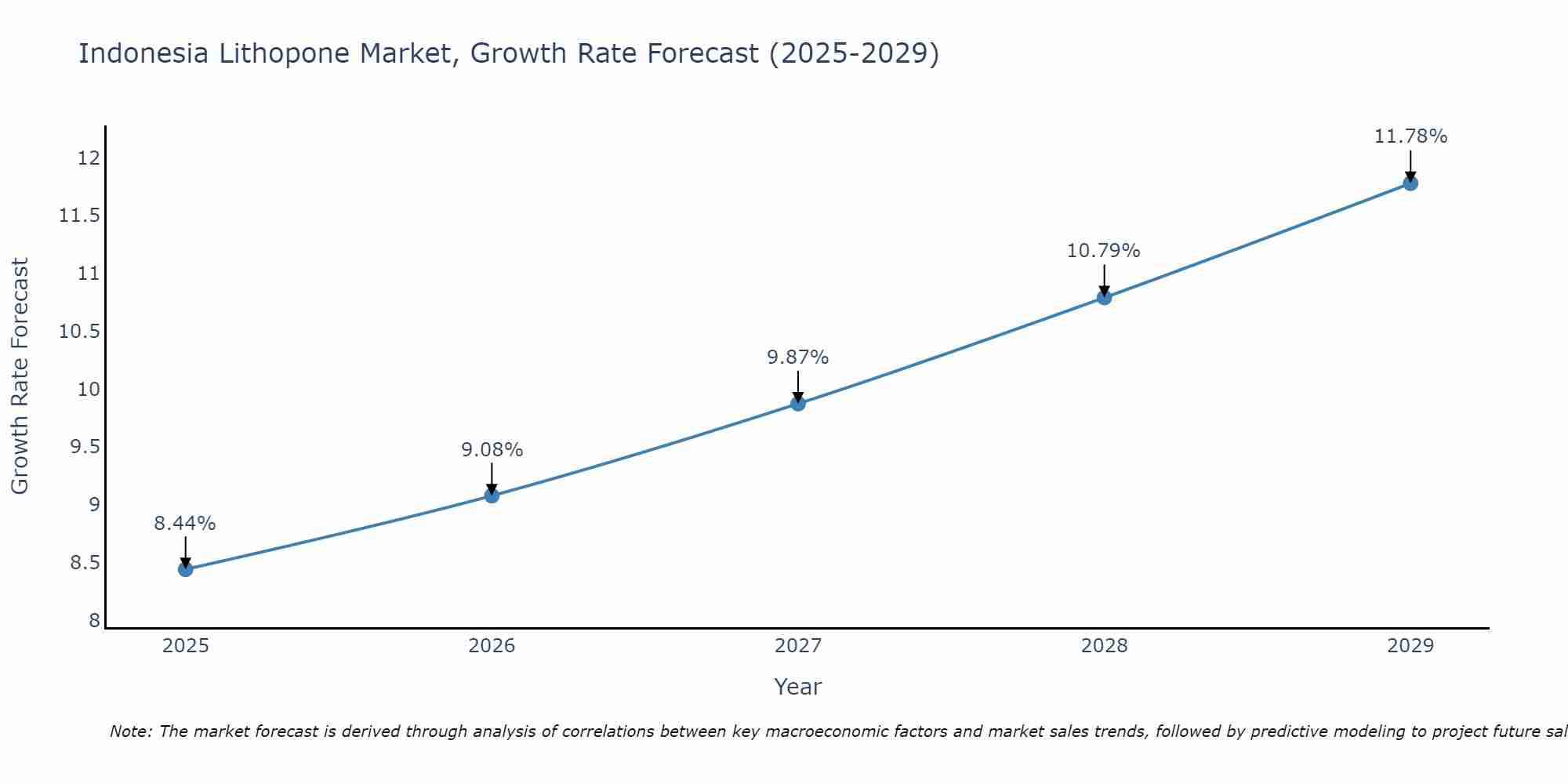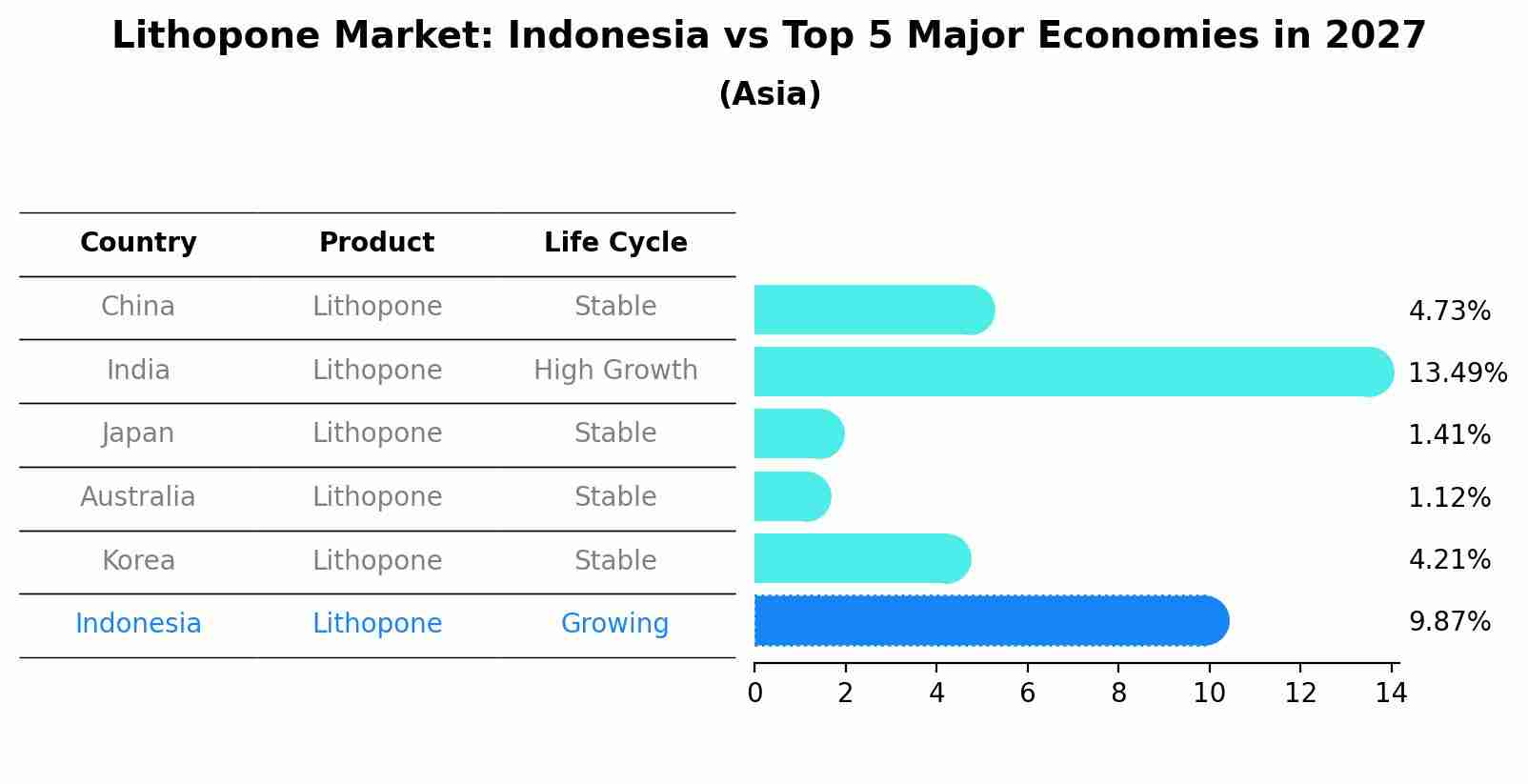Indonesia Lithopone Market (2025-2031) Outlook | Analysis, Forecast, Size, Value, Growth, Industry, Share, Trends, Revenue & Companies
| Product Code: ETC210400 | Publication Date: Jul 2023 | Updated Date: Apr 2025 | Product Type: Market Research Report | |
| Publisher: 6Wresearch | No. of Pages: 60 | No. of Figures: 40 | No. of Tables: 7 | |
Indonesia Lithopone Market Size Growth Rate
The Indonesia Lithopone Market is poised for steady growth rate improvements from 2025 to 2029. From 8.44% in 2025, the growth rate steadily ascends to 11.78% in 2029.

Lithopone Market: Indonesia vs Top 5 Major Economies in 2027 (Asia)
By 2027, the Lithopone market in Indonesia is anticipated to reach a growth rate of 9.87%, as part of an increasingly competitive Asia region, where China remains at the forefront, supported by India, Japan, Australia and South Korea, driving innovations and market adoption across sectors.

Indonesia Lithopone MarketSynopsis
Lithopone, a white pigment composed of barium sulfate and zinc sulfide, is used in paints and coatings in Indonesia. It is an inexpensive alternative to titanium dioxide which has been widely accepted as a white pigment for these applications. Indonesia lithopone market was valued at US$ xx million in 2025 and is projected to reach US$ xx million by 2031, growing at a CAGR of xx%
Market Trends
The rising demand for cost effective alternatives such as lithopone is driving the growth of the Indonesia Lithopone Market. The increasing use of this white pigment across various industries such as paint & coatings industry has further augmented its popularity among customers. Additionally, with more government initiatives focusing on environmental protection, manufacturers are shifting their focus towards eco-friendly pigments like lithopone that do not produce any harmful toxins when exposed to heat or light. This factor too is likely to support the growth prospects of this market over the coming years. Moreover, technological advancements have led to improved product formulations making it more attractive for potential buyers who seek both quality and affordability while purchasing products containing lithium compounds like lithopone from suppliers in Indonesia.
Market Drivers
Increasing acceptance of low cost pigments due to rising prices of raw materials: Growing prices associated with titanium dioxide (TiO2), one of most commonly used white pigment globally has encouraged customers shift their preference towards less expensive substitutes such as Lithpone which provides same visual appeal without compromising on quality standards set by regulatory bodies worldwide.As per estimates offered by industry experts , TiO2 prices witnessed substantial increase year on year since 2025 owing mainly increased demand from countries around world alongside limited availability. Consequently , many customers are now opting for cheaper options available leading rise usage rate soft iron oxide derivatives such as oxides produced using zinc strontium sulphates including Lithpones manufactured within confines Indonesia own borders thereby fuelling overall expansion country?s local markets significantly.
COVID-19 Impact on the Market
The Indonesia lithopone market has been impacted by the COVID-19 pandemic. The demand for industrial products, such as paints and coatings, in which lithopone is used as a pigmenting agent, has dropped significantly due to declining economic activity in the country. In addition, due to travel restrictions imposed by the government during lockdown periods, international trade of lithopone has also been affected.
Challenges of the Market
One of the major challenges faced by manufacturers and suppliers in Indonesia Lithopone market is stringent environmental regulations that limit production activities at factories. Other factors include high costs associated with procurement of raw materials and rising labor costs resulting from minimum wage increases mandated by local governments. Moreover, fluctuating currency exchange rates affect imports into Indonesia making it difficult for companies to predict their profit margins.
Industry Key Players
Some of the key players operating in Indonesia Lithopone Market are PT Gajah Tunggal Tbk., PT Kansai Paint Indonesia Corporation Ltd., PT Nippon Paint (Bekasi), PT RPM International Inc., BASF SE Asia Pacific Pte Ltd., DIC Corporation Japan Ltd., Lanxess AG Singapore Branch Office and Cinkarna Celje dd Slovenia etc.
Key Highlights of the Report:
- Indonesia Lithopone Market Outlook
- Market Size of Indonesia Lithopone Market, 2024
- Forecast of Indonesia Lithopone Market, 2031
- Historical Data and Forecast of Indonesia Lithopone Revenues & Volume for the Period 2021-2031
- Indonesia Lithopone Market Trend Evolution
- Indonesia Lithopone Market Drivers and Challenges
- Indonesia Lithopone Price Trends
- Indonesia Lithopone Porter's Five Forces
- Indonesia Lithopone Industry Life Cycle
- Historical Data and Forecast of Indonesia Lithopone Market Revenues & Volume By Application for the Period 2021-2031
- Historical Data and Forecast of Indonesia Lithopone Market Revenues & Volume By Paints & Coatings for the Period 2021-2031
- Historical Data and Forecast of Indonesia Lithopone Market Revenues & Volume By Plastics for the Period 2021-2031
- Historical Data and Forecast of Indonesia Lithopone Market Revenues & Volume By Printing Inks for the Period 2021-2031
- Historical Data and Forecast of Indonesia Lithopone Market Revenues & Volume By Paper & Pulps for the Period 2021-2031
- Historical Data and Forecast of Indonesia Lithopone Market Revenues & Volume By Rubber for the Period 2021-2031
- Historical Data and Forecast of Indonesia Lithopone Market Revenues & Volume By Leather for the Period 2021-2031
- Historical Data and Forecast of Indonesia Lithopone Market Revenues & Volume By Others for the Period 2021-2031
- Indonesia Lithopone Import Export Trade Statistics
- Market Opportunity Assessment By Application
- Indonesia Lithopone Top Companies Market Share
- Indonesia Lithopone Competitive Benchmarking By Technical and Operational Parameters
- Indonesia Lithopone Company Profiles
- Indonesia Lithopone Key Strategic Recommendations
Frequently Asked Questions About the Market Study (FAQs):
1 Executive Summary |
2 Introduction |
2.1 Key Highlights of the Report |
2.2 Report Description |
2.3 Market Scope & Segmentation |
2.4 Research Methodology |
2.5 Assumptions |
3 Indonesia Lithopone Market Overview |
3.1 Indonesia Country Macro Economic Indicators |
3.2 Indonesia Lithopone Market Revenues & Volume, 2021 & 2031F |
3.3 Indonesia Lithopone Market - Industry Life Cycle |
3.4 Indonesia Lithopone Market - Porter's Five Forces |
3.5 Indonesia Lithopone Market Revenues & Volume Share, By Application, 2021 & 2031F |
4 Indonesia Lithopone Market Dynamics |
4.1 Impact Analysis |
4.2 Market Drivers |
4.3 Market Restraints |
5 Indonesia Lithopone Market Trends |
6 Indonesia Lithopone Market, By Types |
6.1 Indonesia Lithopone Market, By Application |
6.1.1 Overview and Analysis |
6.1.2 Indonesia Lithopone Market Revenues & Volume, By Application, 2021-2031F |
6.1.3 Indonesia Lithopone Market Revenues & Volume, By Paints & Coatings, 2021-2031F |
6.1.4 Indonesia Lithopone Market Revenues & Volume, By Plastics, 2021-2031F |
6.1.5 Indonesia Lithopone Market Revenues & Volume, By Printing Inks, 2021-2031F |
6.1.6 Indonesia Lithopone Market Revenues & Volume, By Paper & Pulps, 2021-2031F |
6.1.7 Indonesia Lithopone Market Revenues & Volume, By Rubber, 2021-2031F |
6.1.8 Indonesia Lithopone Market Revenues & Volume, By Leather, 2021-2031F |
7 Indonesia Lithopone Market Import-Export Trade Statistics |
7.1 Indonesia Lithopone Market Export to Major Countries |
7.2 Indonesia Lithopone Market Imports from Major Countries |
8 Indonesia Lithopone Market Key Performance Indicators |
9 Indonesia Lithopone Market - Opportunity Assessment |
9.1 Indonesia Lithopone Market Opportunity Assessment, By Application, 2021 & 2031F |
10 Indonesia Lithopone Market - Competitive Landscape |
10.1 Indonesia Lithopone Market Revenue Share, By Companies, 2024 |
10.2 Indonesia Lithopone Market Competitive Benchmarking, By Operating and Technical Parameters |
11 Company Profiles |
12 Recommendations |
13 Disclaimer |
- Single User License$ 1,995
- Department License$ 2,400
- Site License$ 3,120
- Global License$ 3,795
Search
Related Reports
- Portugal Electronic Document Management Market (2025-2031) | Strategy, Consumer Insights, Analysis, Investment Trends, Opportunities, Growth, Size, Share, Industry, Revenue, Segments, Value, Segmentation, Supply, Forecast, Restraints, Outlook, Competition, Drivers, Trends, Demand, Pricing Analysis, Competitive, Strategic Insights, Companies, Challenges
- France Electronic Document Management Market (2025-2031) | Strategy, Consumer Insights, Analysis, Investment Trends, Opportunities, Growth, Size, Share, Industry, Revenue, Segments, Value, Segmentation, Supply, Forecast, Restraints, Outlook, Competition, Drivers, Trends, Demand, Pricing Analysis, Competitive, Strategic Insights, Companies, Challenges
- Portugal Occupational Health & Safety Services Market (2025-2031) | Strategy, Consumer Insights, Analysis, Investment Trends, Opportunities, Growth, Size, Share, Industry, Revenue, Segments, Value, Segmentation, Supply, Forecast, Restraints, Outlook, Competition, Drivers, Trends, Demand, Pricing Analysis, Competitive, Strategic Insights, Companies, Challenges
- Netherlands Occupational Health and Safety Services Market (2025-2031) | Strategy, Consumer Insights, Analysis, Investment Trends, Opportunities, Growth, Size, Share, Industry, Revenue, Segments, Value, Segmentation, Supply, Forecast, Restraints, Outlook, Competition, Drivers, Trends, Demand, Pricing Analysis, Competitive, Strategic Insights, Companies, Challenges
- Belgium and Luxembourg Facility Management Market (2025-2031) | Strategy, Consumer Insights, Analysis, Investment Trends, Opportunities, Growth, Size, Share, Industry, Revenue, Segments, Value, Segmentation, Supply, Forecast, Restraints, Outlook, Competition, Drivers, Trends, Demand, Pricing Analysis, Competitive, Strategic Insights, Companies, Challenges
- Russia Women Intimate Apparel Market (2025-2031) | Strategy, Consumer Insights, Analysis, Investment Trends, Opportunities, Growth, Size, Share, Industry, Revenue, Segments, Value, Segmentation, Supply, Forecast, Restraints, Outlook, Competition, Drivers, Trends, Demand, Pricing Analysis, Competitive, Strategic Insights, Companies, Challenges
- Africa Chocolate Market (2025-2031) | Size, Share, Trends, Growth, Revenue, Analysis, Forecast, industry & Outlook
- Global Hydroxychloroquine And Chloroquine Market (2025-2031) | Industry, Trends, Size, Outlook, Growth, Value, Companies, Revenue, Analysis, Share, Forecast
- Saudi Arabia Plant Maintenance Market (2025-2031) | Industry, Size, Growth, Revenue, Value, Companies, Forecast, Analysis, Share & Trends
- Taiwan Electric Truck Market (2025-2031) | Outlook, Industry, Revenue, Size, Forecast, Growth, Analysis, Share, Companies, Value & Trends
Industry Events and Analyst Meet
Our Clients
Whitepaper
- Middle East & Africa Commercial Security Market Click here to view more.
- Middle East & Africa Fire Safety Systems & Equipment Market Click here to view more.
- GCC Drone Market Click here to view more.
- Middle East Lighting Fixture Market Click here to view more.
- GCC Physical & Perimeter Security Market Click here to view more.
6WResearch In News
- Doha a strategic location for EV manufacturing hub: IPA Qatar
- Demand for luxury TVs surging in the GCC, says Samsung
- Empowering Growth: The Thriving Journey of Bangladesh’s Cable Industry
- Demand for luxury TVs surging in the GCC, says Samsung
- Video call with a traditional healer? Once unthinkable, it’s now common in South Africa
- Intelligent Buildings To Smooth GCC’s Path To Net Zero













